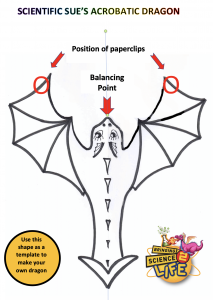Build your own Acrobatic Dragon for Science Week 2021
SCIENTIFIC SUE’S ACROBATIC DRAGON
Amaze your friends and family with this gravity defying balancing Dragon.
Aim of the Activity
Using the template below make a cardboard Dragon and balance it on its nose!
Nuts & Bolts
-
Acrobatic Dragon Template
- Thin card (cereal packets will do),
- scissors,
- sellotape or glue,
- colouring materials,
- paperclips or playdoh or small coins
Secrets for Success
- Download the balance Dragon template (PDF). Print it on card, or print it on regular paper and glue it on the cereal packet card. Cut out the Dragon and colour it in.
- Try to balance the dragon on the tip of your finger. Does it stay? Where does it balance? This point is called its centre of mass.
- You need to move this balance point to the nose of your dragon – and to do this you need to add weights to the front tips of its wings.
- The size of the weights will depend on the thickness of the card that you use. I
- What would happen to the centre of mass if you were to enlarge or reduce the size of dragon?
Science in a Nutshell
All objects have a balancing point, called the centre of gravity. The lower you make the centre of gravity the more stable the object is.
This balancing dragon is a toy that has its centre of gravity located at the tip of its nose. The centre of gravity (also called the centre of mass) is a special point on an object. It’s the point at which the mass of the body Is perfectly balanced.
To engineer it so that the centre of mass it at the tip of the nose the wings have been designed to extend in front of the nose far enough, and made heavy enough (with the addition of the paper clips or other masses), to balance the weight of the bird at its nose.
In most objects it is not clear where the centre of gravity is. If an object has a strange shape, then you cannot know by looking at it where the centre of gravity is. If an object has a uniform shape, like a pencil, or a square, then the centre of gravity is easy to determine. It’s in the centre of the object. But for objects with non-uniform shapes this is not known ahead of time. To find the centre of gravity for these objects you need to use trial and error. You must try balancing the object on different points until you find where the object is perfectly balanced, and doesn’t fall over. This point, once found, is the centre of gravity



